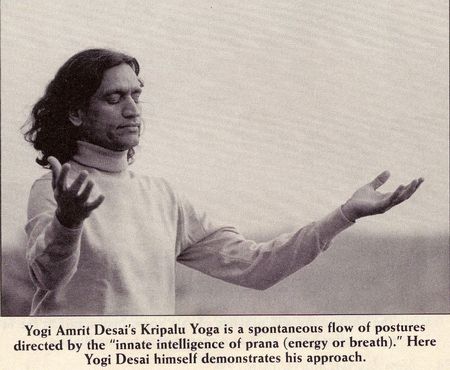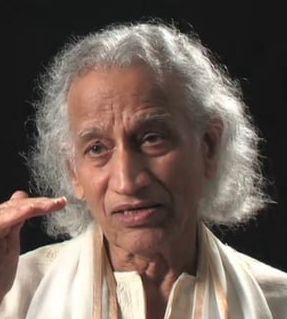Yogi Amrit Desai (1932 - )
 Amrit Desai, 28, arrived in Pennsylvania in 1960 to study at the Pennsylvnia College of Art. This may have been a ruse to enter the USA as Asians were not allowed to immigrate but he quickly became a very successful yoga teacher/entrpreneur. By 1966 he had established the Yoga Society of Pennsylvania (YSP) and had trained 75 teachers. By 1970 he had developed 150 yoga classes, all taught by YSP instructors. "It became the largest yoga society in America," says Desai. "More than 2,000 students graduated from classes every 10 weeks."
In 1969 he returned to India to see his guru, Swami Kripalvananda whose autobiography includes the usual Indian guru stories of an immortal master, Dadaji in this case, resurrection, instant initiation into new secret teachings and a recognition that Dadaji was the spitting image of a statue of the 28th incarnation of Shiva. Simplicity itself, Desai's guru was Bapuji and his guru was the deathless Dadaji and he was really an incarnation of Shiva.
Amrit Desai, 28, arrived in Pennsylvania in 1960 to study at the Pennsylvnia College of Art. This may have been a ruse to enter the USA as Asians were not allowed to immigrate but he quickly became a very successful yoga teacher/entrpreneur. By 1966 he had established the Yoga Society of Pennsylvania (YSP) and had trained 75 teachers. By 1970 he had developed 150 yoga classes, all taught by YSP instructors. "It became the largest yoga society in America," says Desai. "More than 2,000 students graduated from classes every 10 weeks."
In 1969 he returned to India to see his guru, Swami Kripalvananda whose autobiography includes the usual Indian guru stories of an immortal master, Dadaji in this case, resurrection, instant initiation into new secret teachings and a recognition that Dadaji was the spitting image of a statue of the 28th incarnation of Shiva. Simplicity itself, Desai's guru was Bapuji and his guru was the deathless Dadaji and he was really an incarnation of Shiva.
In 1974 Bapuji initiated Desai and empowered him as a guru in his own right even though he had a family and Bapuji had initiated 3 official renunciate swamis. Desai did well as a Yoga teacher but he did even better as a kundalini-raising guru bestowing shaktipat.
Within the Kripalu parampara (lineage), shaktipat is perceived as a profoundly embodied psychophysical experience marking a partial awakening of prana, or energy, of kundalini shakti. After receiving shaktipat the yogi or yogini typically experiences an array of automatic movements and preliminary manifestations called kriyas that could include shaking, crying, dancing, chanting, visions, and spontaneous or automatic asanas (postures) and mudras (advanced postures or hand gestures) - Gleig & Williamson

In 1983 Kripalu moved from Pennsylvania to Lenox, occupying a former Jesuit monastery and Vanderbilt country estate in the Berkshires. Kripalu had 300 residents, served 12,500 guests annually with its numerous yoga and holistic health programs, and oversaw 40 affiliate groups around the country. In 1989 Desai told Hinduism Today that brahmachariya celibacy holds much of Kripalu's power. Men and women live separately, but also eat in different halls and travel in separate cars. There is good harmony too. Notes Desai, "My life is such. No conflicts." A senior staffer half-jokingly confides the only thing they haven't figured out is how to consistently get the staff up for the 5:00 AM meditations. By 1994 Kripalu was considered one of the best holistic health resorts in the US.
Desai had moved into the role of Gurudev, the (semi-)divine teacher with renunciate followers (monks), giving satsang, diksha and shaktipat providing spiritual guidance, and creating his own form of Teaching.
Desai prescribed new norms of behavior for members of the charismatic community after initiation that included foregoing normative sexual relations (that is, celibacy for nonmarried residents and moderation for married residents), and living a life of simplicity and selfless volunteer service.

In 1994 Desai was accused of extramarital affairs with five female residents of the Kripalu Fellowship. Initially he denied the charges thereby adding outright face to face lying to his most devoted followers to the weaselling secrecy and deception he had formerly employed. Eventually Desai admitted the acusations were true and asked for forgiveness. In an almost unique response to the unmasking of a guru's scandalous behaviour, the Board of Directors forced him to resign as Spiritual Director. He was almost the last of his peers to remain free from scandal. This was facilitated by the fact that there was a Board of Directors and rules that could be legally enforced. It's unlikely to have occurred if Desai had complete control of the organisation as is common amongst such gurus. Desai had also been making a lot of money from his position while the followers laboured for a pittance doing seva (service) and left with a lot of money unlike his disillusioned former students. Some things never change.
In 1995, Andrew Cohen, self-proclaimed World Teacher, was able to purchase "Foxhollow," a 220 acre estate in Massachusetts, that once belonged to the Vanderbilts that was part of Desai's Kripalu Yoga Center. The property had come on the market because Yogi Amrit Desai, the married celibate founder and spiritual leader of Kripalu Yoga Center who demanded strict celibacy from his students, owed $3 million to settle some legal claims made against him due to this sexual exploitation of some of his female students.
The Kripalu Center For Yoga and Health reorganised as a "transnational secular yoga retreat" and has continued to thrive. It is no longer based on a Hindu guru-disciple ashram model which has proven such a failure in the West.
 A man with the energy and drive of Desai was not going to remain sulking in the shadows. He began the Amrit Yoga Institute and calls himself Gurudev Amritji Desai. Naturally his website does not mention the years he lied to his followers and his children, cheated on his wife, abused his position of trust, made a fortune from his dedicated disciples and played the role of Gurudev. Oh that's right. He's still playing it. We can be sure that his spiritual practices have certainly raised him above any shame that a less enligtened person might feel. Actually Desai has stated that he believes those years of fucking his female disciples, lying and cheating was "a blessing" that "accelerated his own personal reflection and growth." How much more spiritually advantageous it would have been if he had been even more of a hypocrite? His daughter Kamini wrote:
A man with the energy and drive of Desai was not going to remain sulking in the shadows. He began the Amrit Yoga Institute and calls himself Gurudev Amritji Desai. Naturally his website does not mention the years he lied to his followers and his children, cheated on his wife, abused his position of trust, made a fortune from his dedicated disciples and played the role of Gurudev. Oh that's right. He's still playing it. We can be sure that his spiritual practices have certainly raised him above any shame that a less enligtened person might feel. Actually Desai has stated that he believes those years of fucking his female disciples, lying and cheating was "a blessing" that "accelerated his own personal reflection and growth." How much more spiritually advantageous it would have been if he had been even more of a hypocrite? His daughter Kamini wrote:
"My father's greatest teaching is not in the words he has spoken or the experiences he has conveyed, but in the example he has given of what it means to surrender to life and the mistakes we make as the medium to liberation."
Andrew Cohen commented:
I remember my own disappointment, for I had seen Yogi Desai as the last of the few modern pioneer masters of yoga in the West who, up until that point anyway, had remained free from scandal. What is going on here? I found myself asking over and over again. These great men were true masters after all, men who not only had experienced glorious heights of bliss and ecstasy that most only dream about, but in this case, who also had the power to transmit that experience to others. … So what gives?
The answer is simple. You do not have to be "great men and true masters" to inspire other people. You just have to tell them what they want to hear in a form they find exciting and presto, it's done. There's nothing spiritual about it. If you accept that spirituality, realization and enlightenment do not exist, then it all makes sense.
- Homegrown Gurus: From Hinduism in America to American Hinduism - Ann Gleig & Lola Williamson
Back to Sat Cit Anand.